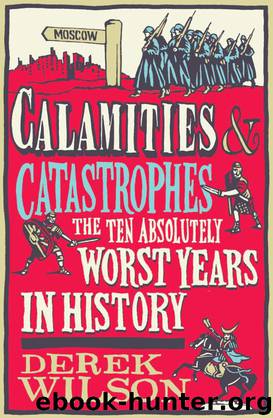Calamities & Catastrophes: The Ten Absolutely Worst Years in History by Wilson Derek

Author:Wilson, Derek [Wilson, Derek]
Language: eng
Format: epub
ISBN: 9781780720166
Publisher: Short Books
Published: 2011-09-19T23:00:00+00:00
Chapter 7
1865–6
Deep rents in the fabric of society take generations, even centuries to mend. If winning a peace is more difficult than winning a war, winning an internal peace in a divided country is many times harder. This is basically why the immediate aftermath of the American Civil War (1861–65) was so immensely tragic. What was called the time of ‘Reconstruction’ was no such thing. No lasting settlement could be built upon the unstable foundation of the ideological differences that persisted between the ‘free’ northern and ‘slave-owning’ southern states of the USA. There were widely disparate expectations about the position of freed Negroes in post war America. There was deep mistrust between those who gathered from the two sides to negotiate a new settlement. This mistrust gave rise to unco-operativeness, repeated violent confrontations and a constitutional conflict that very nearly tore the nation apart.
‘I can embody it all in a few words: beggary, starvation, death, bitter grief, utter want of hope.’ That was the verdict on these months of Henry Timrod, the ‘laureate of the Confederacy’. The poet could speak for thousands of men and women from the southern states of the USA because he shared their experiences to the full. In the civil war, which had just ended, his business had been ruined and he and his wife had had to sell up everything in order to buy food. The coming of peace after years of war is usually a time of rejoicing or at least of relief. This was not the case in the aftermath of the conflict that had tragically divided the slave-owning Confederate states of America from the free societies of the Unionist North. Around 620,000 combatant troops had died in battle. An incalculable multitude of other men and women had fallen victim to starvation or disease. The economy of a large part of the country had been shattered. Farms, villages and towns were reduced to mounds of cold ash. More importantly, bitter hatreds had been sown which would, for many generations, go on producing an evil crop.
By 1861 mainland USA stretched from coast to coast and had almost assumed its present shape. Its constituent parts were either full states of the Union or associated territories. But, at the same time, a stark line of division ran between the members of the nation. Slavery, which had been a major moral issue throughout the Western world since the beginnings of the campaign against the slave trade in the 1770s, was the problem. The southern American states from Virginia to Texas relied largely on plantation agriculture. Producing the cash crops of cotton and tobacco was highly profitable but it was also labour-intensive. It needed a large, cheap workforce. Before abolition, slaves had been imported from Africa. These and their descendants constituted an underclass numbering three and a half million by the mid-nineteenth century. The North, by contrast, was a society of small farms and industrial towns. Its state legislatures had abolished slavery. As the Union expanded and new
Download
This site does not store any files on its server. We only index and link to content provided by other sites. Please contact the content providers to delete copyright contents if any and email us, we'll remove relevant links or contents immediately.
Periodization Training for Sports by Tudor Bompa(8103)
The Body: A Guide for Occupants by Bill Bryson(4896)
The MacArthur Bible Commentary by John MacArthur(4690)
The Sports Rules Book by Human Kinetics(4224)
What It Really Takes to Get Into Ivy League and Other Highly Selective Colleges by Hughes Chuck(3650)
Marijuana Grower's Handbook by Ed Rosenthal(3592)
The Sprouting Book by Ann Wigmore(3516)
The Martian by Andy Weir(3255)
Salt, Fat, Acid, Heat: Mastering the Elements of Good Cooking by Nosrat Samin(3086)
The Bread Bible by Rose Levy Beranbaum(2977)
Harry Potter 4 - Harry Potter and The Goblet of Fire by J.K.Rowling(2952)
Sapiens and Homo Deus by Yuval Noah Harari(2951)
Classic by Mary Berry(2921)
The Marketing Plan Handbook: Develop Big-Picture Marketing Plans for Pennies on the Dollar by Robert W. Bly(2908)
Martha Stewart's Baking Handbook by Martha Stewart(2754)
The Plant Paradox by Dr. Steven R. Gundry M.D(2518)
Screenplay: The Foundations of Screenwriting by Syd Field(2514)
50 Economics Classics by Tom Butler-Bowdon(2489)
The Cambridge Grammar Of The English Language by Rodney Huddleston Geoffrey K. Pullum(2361)
